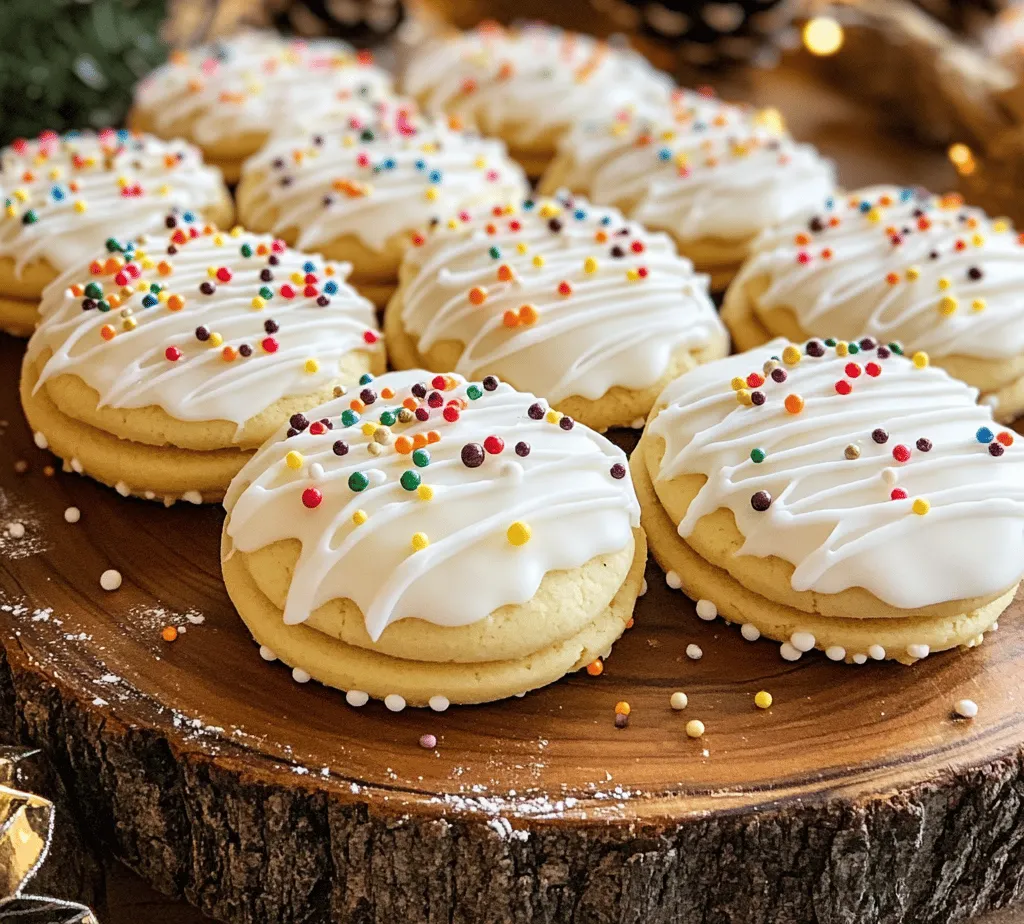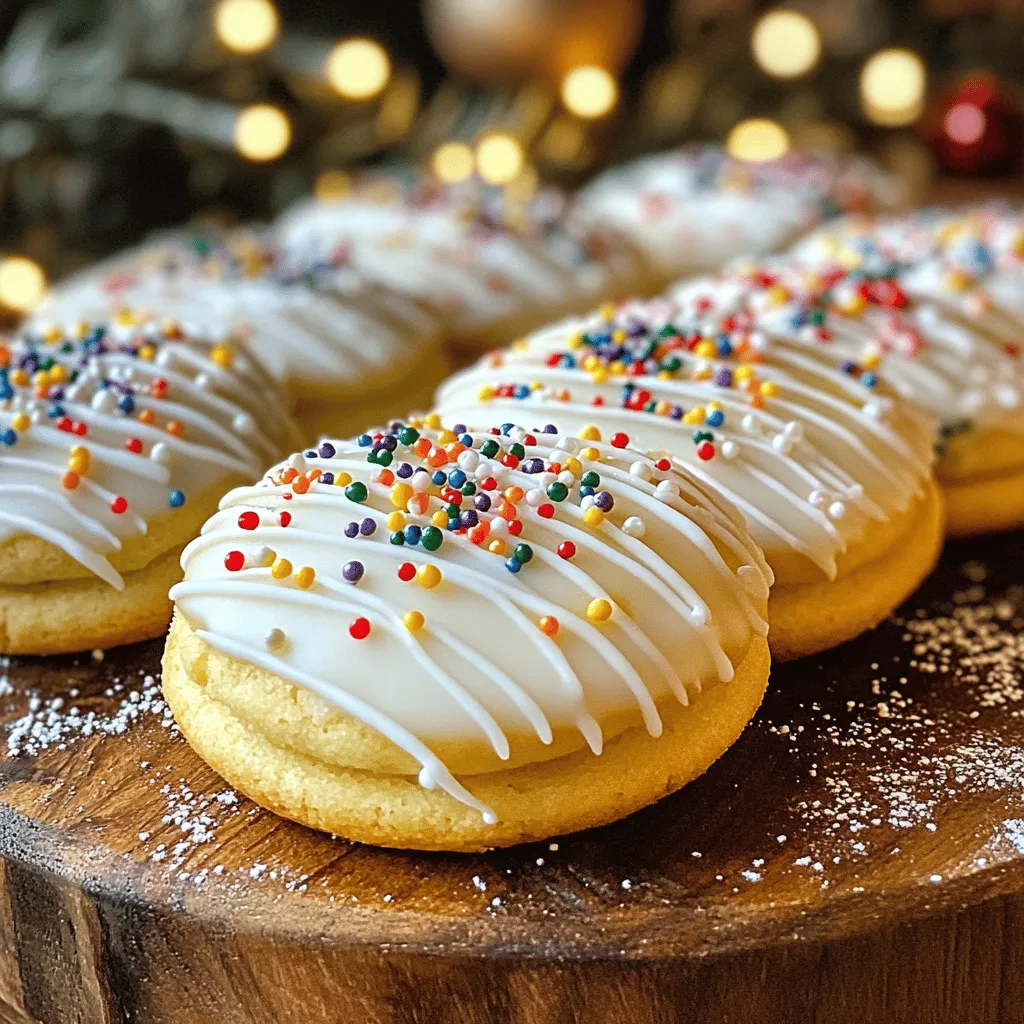Introduction
As the holiday season approaches, the aroma of freshly baked cookies fills homes across the globe, signaling the arrival of cherished traditions and festive cheer. In Italian culture, Christmas cookies hold a special place, serving as a delightful way to celebrate the season and bring families together. These sweet treats are not just desserts; they are a testament to centuries of culinary heritage, each bite infused with flavors that evoke nostalgia and joy.
During Christmas, Italian families engage in the time-honored practice of baking an array of cookies, often passed down through generations. These cookies vary by region, showcasing local ingredients and flavors. From the delicate pizzelle to the rich ricciarelli, each cookie tells a story of heritage, love, and celebration. Among the many varieties, the Festive Italian Christmas Cookies stand out as a delightful addition to holiday gatherings, embodying the spirit of Christmas through their vibrant colors and enchanting flavors.
In this article, we will explore the rich history of Italian Christmas cookies, delve into the significance of the ingredients used in our Festive Italian Christmas Cookies recipe, and guide you through the initial steps of creating these delightful treats. Get ready to embrace your inner baker and bring some Italian flair to your holiday celebrations!
The Heritage of Italian Christmas Cookies
Italian Christmas cookies have a rich history that dates back centuries, with each region of Italy boasting its own unique recipes and traditions. The origins of these festive treats can be traced back to ancient times when families would prepare baked goods to celebrate not only Christmas but also the New Year and other significant events. As families gathered during the holidays, the act of baking cookies became a communal activity, fostering togetherness and creating lasting memories.
In Italy, the holiday season is marked by a variety of traditional cookies, each with its own meaning and significance. For instance, Biscotti di Prato, known simply as biscotti, are often enjoyed with wine and symbolize the importance of sharing and hospitality. Struffoli, tiny fried dough balls coated in honey and colorful sprinkles, are a symbol of abundance and prosperity. Meanwhile, Cucidati, or fig cookies, represent the sweetness of life and are often filled with a blend of dried fruits and nuts.
The flavors that characterize Italian baking during the holidays, especially vanilla and almond, play an essential role in creating these beloved cookies. Almond, in particular, has deep roots in Italian culture, symbolizing good fortune and prosperity. Vanilla, with its warm and comforting aroma, enhances the overall flavor profile, making these cookies even more irresistible.
As we look to create our own batch of Festive Italian Christmas Cookies, let’s take a closer look at the ingredients that will bring these delightful treats to life.
Ingredients Overview
To craft the perfect batch of Festive Italian Christmas Cookies, it is crucial to understand the role of each ingredient in ensuring the best flavor and texture. Here’s a detailed look at what you’ll need:
All-Purpose Flour
All-purpose flour serves as the foundation of our cookies, providing the necessary texture and structure. It is versatile and balances protein content, ensuring that our cookies hold their shape while still being soft and tender. When measuring flour, it’s essential to spoon it into your measuring cup and level it off with a knife to avoid packing it down, which can lead to dense cookies.
Unsalted Butter
Butter is a key player in baking, contributing not only to flavor but also to the richness of the cookies. Using unsalted butter allows you to control the salt level in your recipe more effectively. The butter should be at room temperature, as it will cream better with the sugar, leading to a lighter texture. This step is crucial for achieving the desired melt-in-your-mouth consistency that we all crave in holiday cookies.
Sugar Varieties
In our recipe, we will utilize both granulated sugar and powdered sugar. Granulated sugar is fundamental for creaming with butter, adding sweetness and contributing to the cookie’s structure. On the other hand, powdered sugar will be used for icing, providing a smooth and sweet finish that enhances the festive appearance of our cookies. The combination of these sugars ensures a delightful balance of sweetness in each bite.
Eggs
Eggs are essential in baking, serving multiple functions. They act as a binding agent, helping to hold the ingredients together while also providing moisture. The proteins in eggs contribute to the structure of the cookies, allowing them to rise and maintain their shape during baking. For our Festive Italian Christmas Cookies, one large egg will suffice, ensuring the perfect consistency.
Extracts (Vanilla and Almond)
The flavor profile of our cookies is elevated with the addition of extracts. Vanilla extract is a classic flavor in baking, imparting warmth and sweetness that pairs beautifully with the other ingredients. Almond extract adds a distinctive nutty flavor that is synonymous with Italian baking. Together, these extracts create a harmonious blend that truly embodies the spirit of the season.
Sprinkles and Nonpareils
No festive cookie would be complete without a splash of color! Sprinkles and nonpareils not only add visual appeal but also contribute to the joyous spirit of holiday baking. These decorations can be customized to match your holiday theme, making your cookies not only delicious but also a feast for the eyes.
Step-by-Step Instructions
Now that we’ve gathered our ingredients, let’s dive into the first few steps of preparing our Festive Italian Christmas Cookies.
Preheat the Oven
Before we begin mixing our ingredients, it’s essential to preheat the oven to the appropriate temperature, typically around 350°F (175°C). Preheating ensures that the cookies bake evenly and rise properly. An oven thermometer can be a helpful tool to ensure accuracy, as some ovens may run hotter or cooler than the dial indicates.
Prepare the Dry Ingredients
Next, we’ll prepare our dry ingredients, which is a crucial step in achieving the right texture for our cookies. In a large mixing bowl, combine the all-purpose flour, baking powder, and salt. The baking powder is a leavening agent that will help our cookies achieve a fluffy, tender consistency. The salt enhances the flavors of the other ingredients, ensuring a well-rounded taste.
To mix these ingredients properly, use a whisk to ensure an even distribution. This step is vital, as it prevents clumping and ensures that the baking powder is evenly distributed throughout the flour. Once combined, set the bowl aside while we work on the wet ingredients.
As we progress, we will continue to build on these initial steps to create our delicious Festive Italian Christmas Cookies. Stay tuned for the next part, where we will explore how to cream the butter and sugar, incorporate the eggs and extracts, and ultimately shape our cookies into delightful festive creations!

Creaming Butter and Sugar
The creaming method is a crucial step in baking cookies, particularly for achieving a light and airy texture. When you cream butter and sugar together, you incorporate air into the mixture, which helps to create a fluffy consistency. This process not only contributes to the volume of the cookies but also ensures that they have a tender crumb. For our Festive Italian Christmas Cookies, start by using room temperature butter, as it will blend more easily with the sugar. Beat the butter and sugar together until the mixture is pale and fluffy, which should take about 3 to 5 minutes using an electric mixer. This step sets the stage for the cookies’ delightful texture.
Incorporating Eggs and Extracts
After creaming the butter and sugar, it’s time to introduce the eggs and extracts. Eggs serve as a binding agent, adding moisture and richness to the dough. For this recipe, use fresh eggs at room temperature, as they will mix more seamlessly into the creamed butter-sugar mixture. Along with the eggs, add high-quality extracts like vanilla and almond for added depth of flavor. These extracts not only enhance the cookies’ taste but also infuse them with a delightful aroma that will make your kitchen smell heavenly. Mix the ingredients until just combined, ensuring that the eggs are fully incorporated without overmixing.
Combining Dry and Wet Ingredients
Next, it’s essential to combine your dry and wet ingredients carefully. For this recipe, sift together the flour, baking powder, and a pinch of salt in a separate bowl. Sifting helps to aerate the flour and eliminate any lumps, ensuring a smooth dough. Gradually add the dry ingredients to the wet mixture, mixing on low speed. The key here is to mix until just combined; overmixing can lead to tough cookies. When the dough starts to come together, switch to a spatula to gently fold in any remaining flour, creating a cohesive and slightly sticky dough.
Chilling the Dough
Chilling the dough is a critical step that shouldn’t be overlooked. Refrigerating the dough for at least 30 minutes before baking allows the fats to solidify, which helps maintain the cookies’ shape during baking. Additionally, chilling enhances the flavors as the ingredients meld together. Wrap the dough in plastic wrap or place it in an airtight container, ensuring it’s well-sealed. This step not only makes the dough easier to handle when shaping but also contributes to a tender, chewy texture in the final cookies.
Shaping the Cookies
Once the dough has chilled, it’s time to shape the cookies. For uniform cookie sizes, use a cookie scoop or a tablespoon to measure out portions of dough. Roll each portion into a ball, then flatten them slightly with your palm. This method ensures that the cookies bake evenly and maintain a consistent shape. For a festive touch, consider using cookie cutters to create various holiday shapes, such as stars, trees, or bells. Alternatively, you can use a fork to create an attractive pattern on the surface of each cookie before baking.
Baking
Baking is where the magic truly happens. Preheat your oven to 350°F (175°C) and line your baking sheets with parchment paper. This prevents the cookies from sticking and promotes even baking. Place the shaped cookies on the prepared sheets, ensuring there’s enough space between each cookie to allow for spreading. Bake for about 10-12 minutes, or until the edges are lightly golden. Keep an eye on them; the cookies may look slightly underbaked in the center, but they will continue to firm up as they cool. You’ll know they’re done when they have a golden edge and a soft center.
Cooling Process
After baking, it’s crucial to let the cookies cool properly. Allow them to sit on the baking sheet for about 5 minutes before transferring them to a wire rack. This step allows them to set and makes it easier to move them without breaking. Cooling not only helps the cookies firm up but also enhances their flavor; as they cool, the sugars continue to develop, bringing out the richness of each bite. Be patient during this step, as the cookies will taste even better once they have cooled completely.
Preparing the Icing
No festive Italian Christmas cookie is complete without a beautiful icing. To achieve the perfect icing consistency, mix powdered sugar with a small amount of milk or water until it reaches a smooth, pourable texture. For added flavor, consider incorporating vanilla or almond extract into the icing as well. If you prefer a thicker icing for decorating, simply reduce the liquid. Divide the icing into smaller bowls and add food coloring to create a vibrant palette for your cookie designs.
Decorating the Cookies
Decorating the cookies is where you can truly let your creativity shine. Use piping bags fitted with small round tips to create intricate designs, or simply drizzle the icing over the cooled cookies for a more casual look. You can also use sprinkles, edible glitter, or crushed nuts to add texture and festive flair. For a more traditional touch, consider dusting the cookies with powdered sugar or using a simple royal icing to create delicate patterns. The beauty of these cookies lies in their versatility, allowing you to tailor the decorations to match your holiday theme.
Serving Suggestions
When it comes to serving your Festive Italian Christmas Cookies, presentation is key. Arrange them on a festive platter or in a decorative tin to make a beautiful centerpiece for your holiday gatherings. Pair these delightful cookies with warm beverages such as coffee, hot cocoa, or mulled wine to create a cozy atmosphere. If you’re looking to spread holiday cheer, consider gifting a batch of cookies to friends, neighbors, or coworkers. A beautifully wrapped assortment makes for a thoughtful and delicious holiday gift that’s sure to be appreciated.
Storage and Shelf Life
To keep your Festive Italian Christmas Cookies fresh, proper storage is essential. Store them in an airtight container at room temperature, ideally away from direct sunlight and heat. This method will keep the cookies soft and flavorful for up to a week. If you have leftover cookies and want to extend their shelf life, consider freezing them. Wrap each cookie individually in plastic wrap and place them in a freezer-safe bag. They can be frozen for up to three months. When you’re ready to enjoy them, simply thaw the cookies at room temperature for a few hours.
Conclusion
Baking Festive Italian Christmas Cookies is more than just a culinary endeavor; it’s a cherished tradition that brings families and friends together during the holiday season. The warmth of the oven, the fragrant aroma of freshly baked cookies, and the joy of decorating them create a sense of togetherness that embodies the spirit of Christmas. By following this recipe, you’re not just making delicious cookies, but also creating memories that will last a lifetime. Embrace the festive spirit by trying your hand at this delightful recipe, and let these cookies become a beloved part of your holiday celebrations. Gather your loved ones, share your creations, and enjoy the sweet taste of tradition this holiday season.


